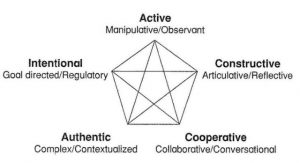This week, I chose to focus my attention on the Carraher, Carraher & Schliemann (1985), Spicer & Stratford (2001), and Yoon, Elinich, Wang & Steinmeier (2012) articles.
When I started reading the Carraher et al (1985) article I wondered the relevance it would have to my Grade 1 students who come from a fairly privileged neighborhood. I quickly realized that the young children in the study who were able to determine the price of ten coconuts without the use of paper and pencil and little to no education were a great example of how to teach mathematics. More than ever, educators are starting to veer away from the traditional math worksheets and teach using a variety of hands-on activities with a wide variety of manipulatives. Had these Brazilian students been sitting in a classroom listening to a teacher speak at the front of a classroom about multiplication, would they have understood the concept as clearly? It is evident that hands-on, applicable learning is key in students understanding mathematic concepts as well as being able to apply them to different situations in their lives.
In the Spicer & Stratford (2001) article, they discussed a VR program called Tidepool and polled students on whether or not they believed VR programs such as this could replace actual field trips. In this particular VR program, students could copy and paste, add hyperlinks, pictures and text from the ‘field notebook’ to their own electronic notebook. This allowed students to gather information that they thought was most informative or valuable to them in an easy and accessible manner. This use of technology reminded me of how inquiry based learning can encourage deep and meaningful learning to occur as students are creating their own understandings based on the information that they deem to be useful. While the consensus of the study demonstrated that VR is not as immersive as actual field trips, it is clear that there is some merit to such experiences, especially when actual field trips are not possible. Utilizing programs like National Geographic’s live cams and Discovery Educations virtual field trips allows me to plan my science and mathematics program to ensure that my students are immersed in as much live content as possible. Being able to follow the life of a bald eagle and see its nesting patterns, etc. versus reading about it in a textbook or even on the web is not the same. Being able to view, in real time, live experiences through virtual realty programs is incredibly intriguing to students.
It is clear that with the inclusion of VR/AR activities, scaffolding and collaboration is key in the successful learning and understanding of students. As Yoon et al (2012) pointed out, “scaffolds would promote collaboration within the peer groups by encouraging students to discuss their observations and reflections of their experience”. This statement clearly demonstrates the importance of discussions when utilizing technology. Without collaborative discussions to outline what the students are examining through virtual realties, connections are not being made and the usefulness of these programs declines. Therefore, it is important for educators to purposefully utilize these programs in conjunction with collaborative activities for learning to occur.
All in all, after reading these article and taking time to explore the different websites/activities provided, it is clear that in order for such programs to be successful in the classroom, they must be utilized in conjunction with a clear plan outlined by the educator. Additional activities that delve into the deeper meaning of these programs and what is being viewed are necessary for deep learning to occur.
References
Carraher, T. N., Carraher, D. W., & Schliemann, A. D. (1985). Mathematics in the streets and in schools. British journal of developmental psychology, 3(1), 21-29.
Spicer, J., & Stratford, J. (2001). Student perceptions of a virtual field trip to replace a real field trip. Journal of Computer Assisted Learning, 17, 345-354.
Yoon, S. A., Elinich, K., Wang, J., Steinmeier, C., & Tucker, S. (2012). Using augmented reality and knowledge-building scaffolds to improve learning in a science museum. International Journal of Computer-Supported Collaborative Learning, 7(4), 519-541.
